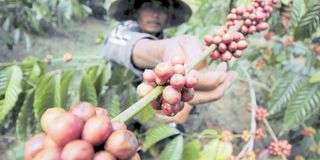High production cuts world’s robusta coffee price by 10pc

A farmer picks coffee berries. PHOTO|FILE
What you need to know:
Robusta coffee farmers in Tanzania will earn low deal this year, following the fall of the commodity price at the world market
Dar es Salaam. Robusta coffee prices fell last year.
That happened because world robusta coffee prices declined by average of 10 per cent from those in 2017, the Bank of Tanzania annual report for 2017/18 shows.
Quoting the World Bank projections, the report indicates that the average global robusta coffee price fell to $2 per kilo in 2018 from $2.2 per kilo in 2017.
The 2018 projected price was equivalent to the price recorded in 2016 and higher than $1.9 per kilo in 2015.
The decrease in the price is attributed to increased production among largest crop producers in the world.
The global coffee output in the current season is estimated at a record 174.5 million bags, up from 15.6 million the last season.
The situation reflects output increases in Colombia and Vietnam.
According to reports by the Tanzania Coffee Board, the government earned $528,000 from the crop exports in 2017/18.
Coffee supports close to 400,000 smallholder farmers in Tanzania who produce 90 per cent of the country’s commodity.
One of the factors that led to a good performance for Tanzania’s coffee in 2017/18 was good climate.
Reports show that in 2016, world production of green coffee beans was 9.2 million tonnes, led by Brazil with 33 per cent of the total. Vietnam, Colombia, and Indonesia were other major producers.
Arabica coffee beans are cultivated mainly in Latin America, eastern Africa or Asia, while robusta beans are grown in central Africa, throughout southeast Asia, and Brazil. Of the two main species grown, arabica coffee (from C. arabica) is generally more highly regarded than robusta coffee (from C. canephora). Robusta coffee tends to be bitter and has less flavor but better body than arabica.




